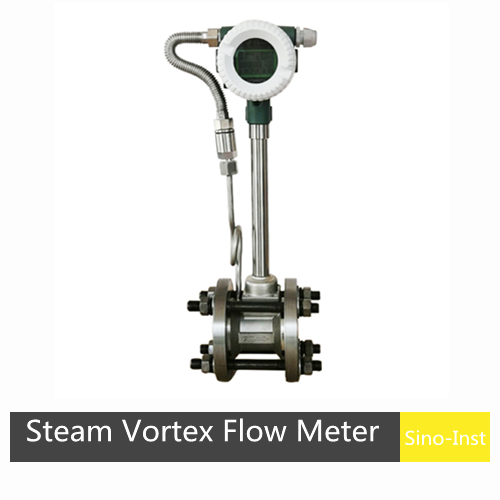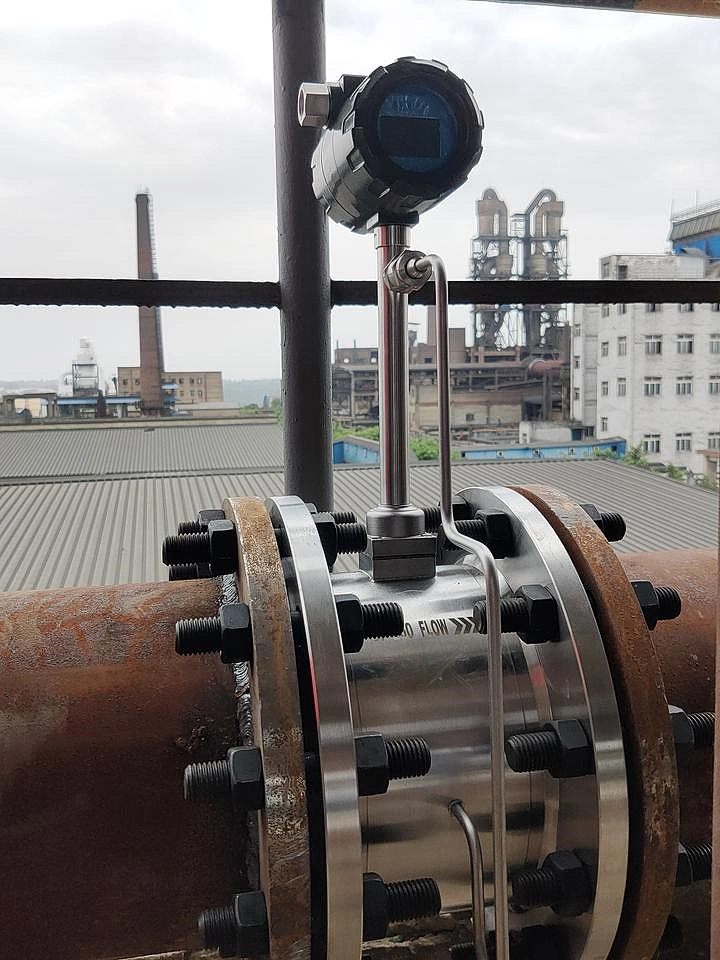The Vortex Steam Flow Meter is suitable for flow measurement of saturated and superheated steam. Integrated temperature and pressure compensation reduces procurement and installation costs, helping you efficiently obtain accurate mass flow, volume flow, temperature, and pressure parameters.
Sino-Inst’s vortex flowmeters offer stable performance, vibration resistance, and high-temperature resistance. They help you maximize the efficiency of monitoring and improving steam production and consumption.

| Diameter | DN15~DN300 |
| Accuracy | 0.5% to 2.0% of reading |
| Temp. range | -40~+420℃ |
| Pressure | 1.6 MPa, 4.0MPa |
| Flow rate | 0.5~6m/s |
| Straight pipe required | Up stream≥5DN, down stream≥3DN |
Features
The vortex sensor utilizes internationally advanced ADSP adaptive digital signal processing technology, implementing adaptive filtering, system identification, signal detection, and analysis.
This sensor offers the following advantages:
Read more about: What Is Temperature Compensation and Pressure Compensation for Flow Meters?
Specifications
| Medium | Saturated steam, superheated steam, etc. |
| Accuracy | Pipe type: Class 1.0 |
| Insertion type: Class 2.5 | |
| Medium temperature | -40℃~+420℃ |
| Nominal pressure | ≤1.6Mpa (offer ≤2.5Mpa and ≤4.0Mpa customization) |
| Flow rate | 5-60m/s |
| Output | Voltage pulse, 4-20mA output, HART, Modbus, RS485, RS232 options. |
| Installation | Flange, wafer flange, insertion, threat, clamp connection |
| Power | 12~28VDC |
| 3.6V lithium battery (on site display) | |
| 85~265VAC (Remote display) | |
| Operating condition | Temperature: -25℃~60℃ |
| Humidity: 5%~90% | |
| Housing material | 1Cr18Ni9Ti |
Order Guide
In addition to regular products, we support customization
| SI-3303- | Note | |||||||||||
| Nominal diameter | DNXX | DN15~DN1800 (mm) | ||||||||||
| Structure | F | Remote type with display | ||||||||||
| Y | Compact type with display | |||||||||||
| Accuracy | A | Pipe type: Class 1.0 | ||||||||||
| B | Insertion type: Class 2.5 | |||||||||||
| Nominal pressure | 16 | 1.6Mpa | ||||||||||
| XX | Customization | |||||||||||
| Medium | S | saturated steam | ||||||||||
| O | superheated steam | |||||||||||
| The temp. of medium | M | <250℃ | ||||||||||
| H | >250℃ | |||||||||||
| Other function | P | With pressure compensation | ||||||||||
| T | With temperature compensation | |||||||||||
| PT | With pressure and temperature compensation | |||||||||||
| Power supply | 1 | 12~28VDC | ||||||||||
| 2 | 3.6V lithium battery (on site display) | |||||||||||
| 3 | 85~265VAC (Remote display) | |||||||||||
| Output signal | A | 4-20mA | ||||||||||
| M | Voltage pulse | |||||||||||
| H | HART | |||||||||||
| R1 | RS232 | |||||||||||
| R2 | RS485 | |||||||||||
| Installation | 1 | Flange | ||||||||||
| 2 | Clamp flange | |||||||||||
| 3 | Insertion | |||||||||||
| 4 | Thread | |||||||||||
| 5 | Clamp | |||||||||||
| Explosion proof | A | No explosion proof | ||||||||||
| B | Intrinsic explosion proof | |||||||||||
| G | Flame proof | |||||||||||
Challenges of Steam Flow Measurement
Steam is divided into saturated steam and superheated steam. Measuring their flow rates presents the following challenges:
- High Temperature and High Pressure: Steam temperatures can reach over 200°C and pressures can exceed 10 MPa, requiring flowmeters with high temperature and high pressure resistance.
- Phase Change Effects: Saturated steam can easily condense into water due to temperature or pressure fluctuations, affecting measurement accuracy.
- Large Flow Rate Variation: Steam flow fluctuates significantly due to load, requiring a flowmeter with a wide turndown ratio.
- Pipeline Vibration: Steam flow can cause pipeline vibration, affecting the stability of some flowmeters.
Therefore, steam flowmeters must possess high temperature resistance, anti-interference properties, and high accuracy.
Read more about:

Vortex Steam Flow Meters in Various Steam Applications
- Thermal Power Generation: Vortex flowmeters are used to measure boiler steam outlet flow, ensuring power generation efficiency and safe operation.
- Chemical Production: Vortex flowmeters are used to measure flow during steam heating, ensuring process stability and accuracy.
- Pharmaceutical Industry: Vortex flowmeters are used to measure flow during steam sterilization to ensure sterilization effectiveness.
- Food Processing: Vortex flowmeters are used to measure flow during steam heating to ensure food safety and quality.
Flow Control Methods with Steam Vortex Flowmeters
- Manual Adjustment
Manual flow control using a steam vortex flowmeter requires adjustment of the flowmeter itself. First, connect the flowmeter to a regulating valve, then adjust the valve opening to control the flow rate. The following points should be considered during adjustment:
Precision Adjustment: Gradually open or close the regulating valve to achieve the set flow rate.
Stability Adjustment: Slowly open or close the regulating valve to avoid flow fluctuations or excessive or insufficient flow.
- Automatic Control
Automatic control using the Sino-Inst steam vortex flowmeter can be achieved by connecting it to an electronic regulator or PLC system. By inputting a set flow rate into the controller, the controller automatically adjusts the valve opening based on the actual flow rate measured by the sensor to achieve the set flow rate. The following points should be considered during automatic control:
- Selecting a Suitable Controller: The controller should have good adaptability, controllability, and stability.
- Ensuring Sensor Accuracy: The sensor should have good stability and accuracy to accurately measure flow.
When using a Vortex Steam Flow Meter to control flow, please note the following points:
- Installation Location: The flowmeter should be installed on a straight section of the fluid pipeline, avoiding bends or dead ends.
- Fluid Properties: Ensure that fluid parameters such as temperature, pressure, and viscosity are known to ensure accurate measurements.
- Maintenance: Regular cleaning and calibration are required to ensure accurate measurements.
More Flow Measurement Solutions
The Vortex Steam Flow Meter demonstrates exceptional performance in steam measurement. Its high accuracy, high reliability, low maintenance costs, and adaptability make it a valuable option for modern steam measurement technology.
Sino-Inst’s Vortex Steam Flow Meter will be used more extensively and extensively in steam measurement, providing more accurate and reliable flow measurement support for industrial production. If you require steam flow measurement, please feel free to contact our sales engineers!
-1.jpg)